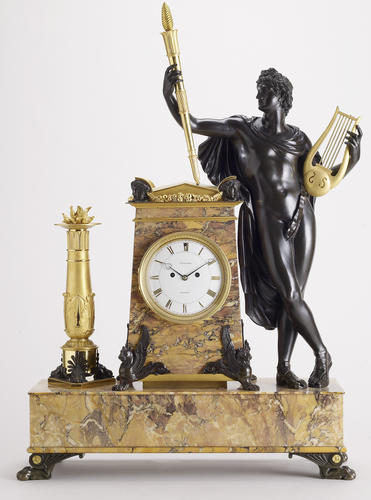Mantel clock 1800-10
Siena marble, patinated and gilded bronze, glass, enamel, blued steel | 73.7 x 52.1 x 18.4 cm (whole object) | RCIN 2757
-
Mantel clock: the case of yellow Siena marble which is mounted, to the right, with a standing figure of Apollo in patrinated bronze holding a gilded staff and lyre and, to the left, a gilded flaming torch. The pediment of the clock is decorated with four mask heads at the corners joined at the front and to the left with a swag of fruit. The clock case is supported by a winged patinated bronze sphinx at each corner within a rectangular marble case. The whole is supported by four lions' paw feet decorated with stylised scrolls.
The mechanism comprises an 8 day rack striking clock with a fusee movement and ½-dead beat escapement. The glazed enamel dial has the 12 hours represented in gilt Roman numerals and a pair of blued steel pierced spade hands. Included in the Pictorial Inventory of 1827-33 – RCIN 934732, a similar clock is RCIN 2744. The inventory was originally created as a record of the clocks, vases, candelabra and other miscellaneous items from Carlton House, as well as selected items from the stores at Buckingham House, the Royal Pavilion, Brighton, Hampton Court and Kensington Palace for consideration in the refurbishment of Windsor Castle.
Vulliamy number 744.Provenance
Possibly bought for the Prince of Wales from Martin-Eloy Lignereaux in Paris (bill dated 28 April 1803) for £85. Ligneruex's premises in the rue Vivienne appears to have been inundated with English tourists during the brief interlude in the Napoleonic wars from 1802-3. Some complained his prices were too high but others enthused over the excellent quality of his stock. One visitor, Bertie Greatheed, recorded in March 1803 'Nothing can be more beautiful and more costly. Tables and Secretaires of yew, with gilt and Bronze ornaments for 1000 Louis. For 30 per Ct. advance he will deliver them to England. He says the chief sale is there. The bronze figures supprting candles, the lamps, the clocks, the china tables are all in the richest and best taste'. The original movement was replaced by Benjamin Lewis Vulliamy in 1821 for £25. 4s. (no. 744). There is a similar clock in the Royal Collection (RCIN 2744) with a movement by Charles-Guillaume Manière. The son of a Parisian master clockmaker, Manière became a maître in 1778 and continued to be active in Paris between 1778-1812. He had premises, from 1781 at rue des Prouvaires, from 1789 at rue des Merciers, from 1806 in the rue Christine and finally from 1810-12 in the rue Bertin-Proirée. He was the principal clockmaker to the marchand-mercier Dominique Daguerre and his successor Martin-Eloi Lignereux who supplied works of art to George IV when Prince of Wales. He also collaborated with ébénistes and bronzeurs, including Pierre-Philippe Thomire and François Rémond, who produced cases for his clocks. Daguerre was closely involved in the decoration at the Royal Pavilion, Brighton, and Carlton House for the Prince of Wales . It is likely, therefore, that the original movement of this clock was also by Manière. The clock stood in the Library Anteroom at the Royal Pavilion. It was moved to Buckingham Palace in 1847 after the sale of the Royal Pavilion by Queen Victoria, where it remains.
-
Creator(s)
? (clockmaker (original movement))(clockmaker (movement))(retailer/supplier)(nationality)Acquirer(s)
-
Medium and techniques
Siena marble, patinated and gilded bronze, glass, enamel, blued steel
Measurements
73.7 x 52.1 x 18.4 cm (whole object)
Object type(s)








